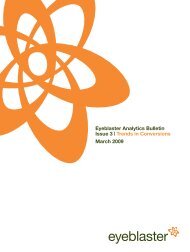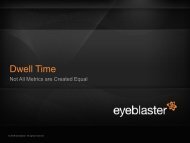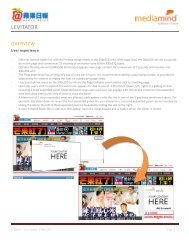EyEBlASTER BEnCHMARk InSIgHTS - MediaMind
EyEBlASTER BEnCHMARk InSIgHTS - MediaMind
EyEBlASTER BEnCHMARk InSIgHTS - MediaMind
You also want an ePaper? Increase the reach of your titles
YUMPU automatically turns print PDFs into web optimized ePapers that Google loves.
Benchmark Insights:<br />
Using Dwell to Measure Advertising Effectiveness<br />
Dwell and Branding<br />
New research by Eyeblaster, Microsoft Advertising and comScore<br />
shows that Dwell does have an actual effect on brand metrics.<br />
The research investigated the differences between campaigns<br />
with a low active engagement as measured by a low Dwell<br />
and campaigns with a high active engagement as measured<br />
by a high Dwell.<br />
“The robust methodology of the<br />
research ensured any positive brand<br />
uplift observed was due exclusively to<br />
the increase in Dwell.”<br />
The study examined a sample of high Dwell campaigns and a<br />
sample of low Dwell campaigns and compared the difference<br />
between them in terms of their brand effects. The robust<br />
methodology ensured any positive brand uplift observed was<br />
due exclusively to the increase in Dwell.<br />
The sample of campaigns was taken out of 800 Rich Media<br />
campaigns that were served by Eyeblaster exclusively on<br />
Microsoft Advertising sites between January 2009 and June<br />
2009. The 800 campaigns were ranked by total Dwell scores. 4<br />
To ensure a distinct difference between high and low Dwell,<br />
the study analyzed campaigns that fell in the top and bottom<br />
10% of the Dwell scale.<br />
Overall, 10 campaigns from the low Dwell group and 10 campaigns<br />
from the high Dwell group were chosen for the analysis. These<br />
20 were selected for having the largest number of impressions,<br />
ensuring the biggest sample sizes for our analysis of over 6,500<br />
panelists. The campaigns covered eight industry verticals.<br />
Campaigns with high Dwell are 3x<br />
more effective at driving search than<br />
campaigns with a low Dwell.<br />
Uplift between unexposed and exposed was averaged for the<br />
10 low Dwell and 10 high Dwell campaigns. These average<br />
uplifts were compared to evaluate the impact of increased<br />
Dwell on subsequent brand effects.<br />
The results of the study indicate that users who were exposed to<br />
campaigns with a high Dwell are more likely to search for brand<br />
related keywords as compared to users who were exposed<br />
to campaigns with a low Dwell. The research found that users<br />
who were exposed to campaigns with a low Dwell increased<br />
brand related keyword searches by 12%, as compared to the<br />
control group, while users who were exposed to campaigns<br />
with a high Dwell increased brand related keyword search<br />
by 39%, as compared to the control group. This shows that<br />
campaigns with high Dwell are 3x more effective at driving<br />
search than campaigns with a low Dwell.<br />
Furthermore, campaigns with a low Dwell increased advertisers’<br />
site traffic by 10%, as compared to the control group, while<br />
campaigns with a high Dwell increased site traffic by 17%. This<br />
is an incremental change of 69% between campaigns with low<br />
Dwell and campaigns with high Dwell. Campaigns with a high<br />
Dwell also increased brand engagement – increasing page<br />
views and time spent on the brand’s site. 5<br />
For each of the 20 campaigns, comScore identified people<br />
that had been exposed to the ads. comScore measured those<br />
panelists’ subsequent online behavior across a four week period<br />
and compared those to unexposed panelists and their online<br />
behavior. These groups were pair matched – the exposed/<br />
unexposed groups were equal except for the fact that the<br />
exposed group had seen the ads, the unexposed had not.<br />
Groups were matched to ensure equality according to specific<br />
demographic and online behavioral variables.<br />
4<br />
To capture both the effect of Dwell Rate and of Average Dwell Time, the research examined the Total Dwell which was defined as Dwell Rate multiplied by<br />
Average Dwell Time.<br />
5<br />
Available for download at: http://advertising.microsoft.com/europe/dwell-on-branding<br />
5 Eyeblaster benchmark insights








